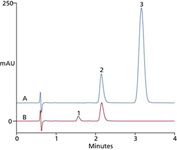Analysis of Nicotine Salts by HPLC on an Anion-Exchange/Cation-Exchange/Reversed-Phase Tri-Mode Column
Nicotine is a famously addictive alkaloid found in tobacco. Controlled doses of nicotine compounds are sometimes used to help tobacco users quit smoking.
Mark Tracy and Xiaodong Liu, Dionex Corporation
Nicotine is a famously addictive alkaloid found in tobacco. Controlled doses of nicotine compounds are sometimes used to help tobacco users quit smoking. Nicotine bitartrate and nicotine salicylate are two commonly used salts in drug formulations. Nicotine is both hydrophilic and basic, making it somewhat difficult to analyze with conventional C18 columns. Furthermore, analysis of the counterions is necessary to assess the mass balance. While salicylate may be analyzed by reversed-phase methods, tartrate is not amenable.
The Acclaim® Trinity™ P1 is a unique, high-efficiency, silica-based column designed for pharmaceutical applications. Its selectivity is based on simultaneous cation exchange (CEX), anion exchange (AEX), and reversed-phase (RP) that can be easily optimized by adjusting mobile phase buffer concentration, pH, and solvent content. For this reason, this column was used in the current work to develop a simple, reliable, and fast method.
Experimental
The LC system consisted of an LPG-3400 RS pump, WPS-3000 RS sampler, TCC-3000 RS column oven, DAD-3000 RS diode-array detector, and Chromeleon® 6.8 Chromatography Data System (Dionex Corp., Sunnyvale, California). The column was an Acclaim Trinity P1, 3 µm, 3 × 50 mm from Dionex.
Discussion
Because the analytes of interest are charged and have a chromophore, mobile phases containing acetonitrile and phosphate buffer were investigated. To achieve optimal separation with a desired k' >1, Rs >2, and analysis time <5 min, 25% acetonitrile and a pH 6.3 sodium phosphate buffer were selected. Under this condition, nicotine is retained by CEX and RP, salicylate by AEX and RP, and tartrate mainly by AEX alone. As shown in Figure 1, simultaneous separations of nicotine and its counterions in two different formulations were obtained on a 3 × 50 mm Trinity P1 column. The main variables in optimization of the mobile phase are ionic strength, solvent strength, and pH. The type, charge, and concentration of cations and anions also affect the separation. We found that sodium gave better selectivity than potassium by affecting nicotine, and that the ratio of dibasic phosphate (stronger eluent) to monobasic (weak eluent) affected retention of anionic counterions. Acetonitrile concentration was used for adjusting selectivity of hydrophobic ions.

Figure 1: Nicotine salicylate (A) and nicotine tartrate (B) on an Acclaim Trinity P1 column. Mobile phase: 1.07 g dibasic sodium phosphate dodecahydrate (3 mmol) + 1.80 g monobasic sodium phosphate (15 mmol) + 27 mg tetrasodium pyrophosphate decahydrate (60 µmol) + 750 g water (750 mL), pH 6.3 + 196 g acetonitrile (250 mL). Flow rate: 0.60 mL/min. Temperature: 30 °C. Detection: UV at 210 nm. Peaks: 1) tartrate, 2) nicotine, 3) salicylate.
Both tartrate and salicylate are chelating acids, and metal contamination on the column will affect their peak shapes. A small amount of pyrophosphate (50 to 100 µM) in the mobile phase prevents metal accumulation on the column without altering the selectivity.
Acclaim and Chromeleon are registered trademarks and Trinity is a trademark of Dionex Corporation.
Dionex Corporation
1228 Titan Way, P.O. Box 3603, Sunnyvale, CA 94088
tel. (408) 737-0700, fax (408) 730-9403
Website: www.dionex.com

The Benefits of Custom Bonded Silica
April 1st 2025Not all chromatography resins are created equal. Off-the-shelf chromatography resins might not always meet the rigorous purification requirements of biopharmaceutical manufacturing. Custom bonded silica from Grace can address a wide range of separation challenges, leading to real performance improvements. Discover more about the latest innovations in chromatography silica from Grace, including VYDAC® and DAVISIL®.
5 Things to Consider When Selecting a Chromatography Silica
April 1st 2025Particularly in the pharmaceutical industry, drug purity isn’t just a goal – it’s essential for achieving safety, stability and efficacy. However, purification is easier said than done, especially with challenging molecules like DNA and RNA “oligonucleotides,” due in large part to their diversity and the range of impurities that can be generated during production. Enter DAVISIL® chromatographic silica, with a wide range of pore diameters and particle sizes to meet your specific application, performance and sustainability requirements. Before you choose the chromatography resin for your next purification application, take a look at these 5 considerations.
Automating Protein Purification: Efficiency, Yield, and Reproducibility
March 27th 2025Recent advancements in automated protein purification stress the importance of efficiency, scalability, and yield consistency. This eBook compares different purification platforms, highlighting their impact on downstream applications and demonstrating how automation enhances throughput and process control.
MilliporeSigma: Ultrapure Water for Sensitive LC-MS Analysis of Pesticides
March 25th 2025The aim of the study was to illustrate the efficiency of Milli-Q® water purification systems in eliminating pesticides from tap water, thereby producing and delivering reliable and consistent-quality ultrapure water suitable for pesticides analysis















